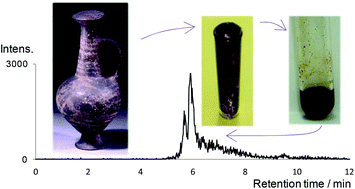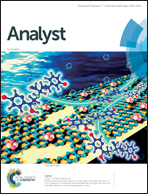Detection of opium alkaloids in a Cypriot base-ring juglet†
Abstract
A method has been developed for extracting poppy alkaloids from oily matrices, specifically lipid residues associated with archaeological ceramics. The protocol has been applied to fresh and artificially aged poppyseed oil and to residue from a Late Bronze Age Cypriot juglet in the collections of the British Museum. The juglet is of a type that has been linked with ancient trade in opium due to its poppy-head shape and wide distribution; it is a rare example of an intact vessel with contents sealed inside. Bulk analysis of the residue by GC-EI-MS and pyGC-EI-MS indicated a degraded plant oil and possible presence of papaverine. Analysis of the alkaloid extracts by HPLC-ESI-MS using both triple quadrupole and FTICR mass spectrometers detected the five primary opium alkaloids in fresh poppyseed oil and papaverine in most of the aged samples. Papaverine and thebaine were detected in the juglet residue, providing the first rigorous chemical evidence to support a link between this vessel type and opium, or at least poppies. The association of opium with oil raises new questions about the ancient purpose of the commodities within these vessels, and the low levels (ng g−1) of opiates detected in this unusually well-preserved residue shed doubt on the scope for their detection in more fragmentary ceramic remains (potsherds). Papaverine was found to exhibit challenging carryover behaviour in all the analytical methods used in this study. The phenomenon has not been reported before and should be considered in future analyses of this analyte in all application areas.

- This article is part of the themed collection: Analyst Recent HOT articles


 Please wait while we load your content...
Please wait while we load your content...